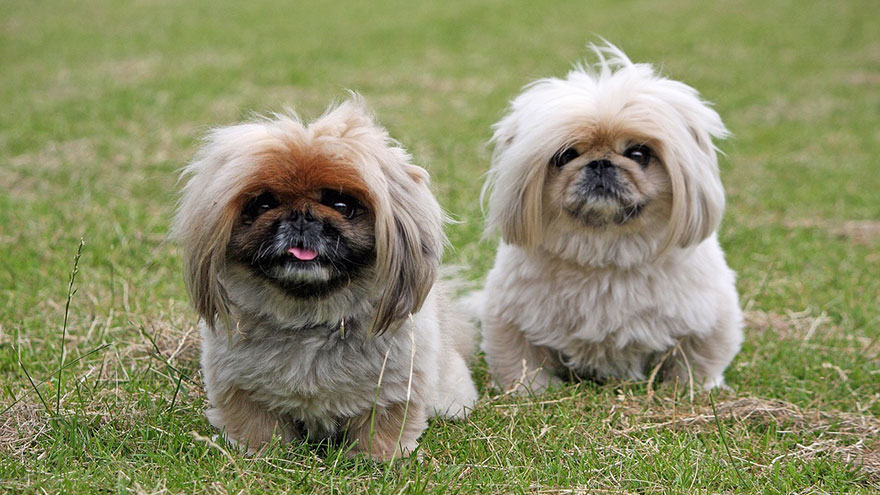Pekingese : 10 Most Common Questions
Some owners and breeders will tell you that the Pekingese may not be the best dog for a first time owner. With the right start from a good breeder and consistent training at home, this toy dog can be a fine pet. The Pekingese can be a bit stubborn and self-important, making obedience and training a challenge.
However, this is also a loyal and courageous little dog that is the only choice for some who live in apartments and smaller homes.
We have put together 10 of the most common questions about Pekingese and answers for each.

1. What is the history of the Pekingese?
This tiny breed of dog has been around for hundreds of years and was a favorite with the royalty of China. In fact, some considered the dog almost divine and commoners were expected to bow to the dog.
One of the oldest breeds of dog, the Pekingese was at one time only owned by those who lived in the Chinese Imperial Palace. The Pekingese has been in Europe and the United States since the mid-1860s through the first years of the 20th century.
2. I have heard the Pekingese is hard to train, is this true?
Generally, toy dogs are among the hardest to housebreak and the Pekingese may be a bit stubborn when it comes to training. Unfortunately, it takes firm voice commands and a lot of patience to get a young Pekingese to fit well with a family.
The good news is that the rewards in loyalty are often worth it. The best of the breed can be groomed and trained to become excellent show dogs.
3. Is this tiny dog fragile?
The Pekingese is really a solid and muscular dog. In fact, some people are surprised at how heavy and strong the animal feels when the dog is picked up. A Pekingese may weigh as much as 14 pounds, though 10 pounds is more common.
This breed can have some problems with their backs and do not do well with rough play.
4. Does the Pekingese have problems with breathing?
Pekingese dogs have small skulls and flat faces that can cause some problems with breathing. These problems can be made worse by long exposure to extremely warm or cold weather.
Owners should always watch for signs of trouble with breathing and the common “cold.” In addition, the Pekingese usually does not have a problem with “weeping” eyes. Any sign of this should be shown to a veterinarian right away.
5. Is the Pekingese hard to groom?
The answer to this question is not easy. Some owners and breeders say no, because the Pekingese is an average shedder and does not spend much time outside to get the coat dirty and tangled.
However, new owners should be prepared to spend some time brushing and combing, on a regular basis. This will keep the long hair from becoming matted.
6. Does the Pekingese’ eyes have special problems because of the way they are set?
Yes, there can be some problems with the eyes because they do not sit deeply in the sockets like other dogs’ eyes. Owners should be careful that the eyes are not injured by sharp objects or edges of furniture.
This reason is yet another on why you want to be careful when around children who might want the dog to play too roughly. In addition, the eyes can be injured in this way.
7. What will it cost to buy a Pekingese from a good breeder?
Prices can vary quite a bit. The amount can range from a few hundred dollars to thousands for a Pekingese with the right bloodlines and documentation. This will depend on whether you want a family pet or a top show dog.
One way to get a fine Pekingese without spending a lot is to get your dog from a good rescue program. The challenges in raising an adult dog are different but these animals can also make fine pets.
8. What color of Pekingese is best?
The color depends on personal preference. The red sable color of Pekingese is the most common, though many people prefer blonde, white, or black.
White is sometimes chosen for show purposes but any Pekingese can be beautiful and well behaved with the right training and home atmosphere.
9. Is the Pekingese courageous, even fearless, in spite of its size?
Yes, this breed is very courageous, actually protecting its owner aggressively. It may take the Pekingese some time to get comfortable with other dogs.
In addition, this breed is naturally wary of strangers, sometimes growing close to only one person. Their temperament leads them to challenge other dogs and strangers, at least with plenty of barking.
10. When a Pekingese walks or tries to run, they seem to trot, why is this?
The Pekingese has naturally short legs, which contributes to the unique gait. However, the main reason is that the dogs were bred by Chinese royalty to be close companions.
For this reason, the bowed legs were encouraged in breeding to prevent the dogs from running away. The Pekingese will however, be able to keep up with you quite well.
Read More About Pekingese
- Pekingese Breed Information
- Pekingese Training Guide
- Pekingese Health Guide
- Owning a Pekingese : Breeder Recommendations

